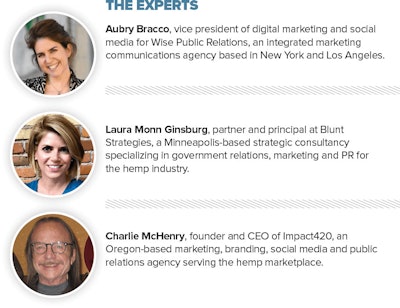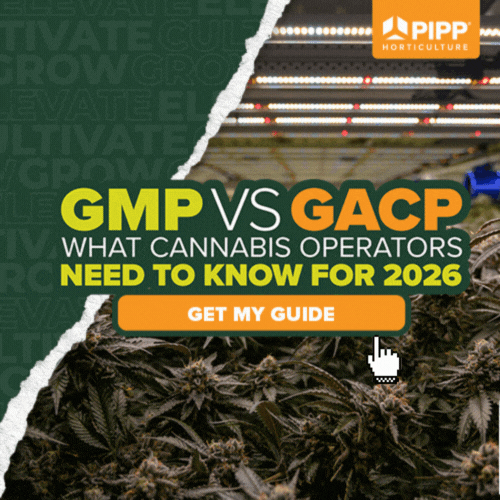

Social media has matured from its simple, sociable roots to become a critical component of any successful marketing initiative. Whether you’re new to hemp or a seasoned grower, succeeding on social media is crucial to building your hemp brand and spreading the word.
To help you make the most of your posts and avoid unnecessary social setbacks, Hemp Grower spoke with three social media experts working in the hemp space.
The following are their tips to help your hemp company achieve social media success.

1. Be Proficient, Prepared and Predictive.
Bracco: “We often think of social media in the larger sense as ‘Oh, it’s just social media,’ but part of the job is navigating compliance and law, state by state and in the U.S. and Canada, daily. You have to be thorough and understand what you can and cannot do. … You have to come in prepared with compliance rules as they currently stand, and you have to be predictive regarding trends affecting social [media] and the industry. It’s something you have to have your finger on the pulse of every day.”
2. Craft a Compelling Story.
McHenry: “Every company, large or small, needs to have a story—a background narrative that really explains their reason for being and their vision going forward and establishes their core messaging. … Every farm has a story. It came into being for a reason. There’s a family involved. There’s land. As the French say, there’s the terroir. ... All those things combine. All can be elements of a compelling story that is the heartbeat of their business.”
3. Define and Refine Your Voice.
Ginsburg: “Even though social media platforms are designed for easy use, I recommend taking a second to step back. Start with figuring out: What is your voice, what do you look like, what do you sound like? If somebody was shown 10 different posts, would they be able to pick out the three that were you because there’s some consistency and familiarity in how you are representing yourself? … Taking that time to really define your voice and settle into what feels right is a really important starting point. [Social media] is just not something to be entering into lightly, even though it’s quick and easy to get started.”
4. Decide What Platforms Are Appropriate for Your Business.
McHenry: “Some are obvious for everybody: Facebook and Instagram, for instance. In the hemp community on Reddit, you have a large and self-organized group of hemp growers, brokers, extractors and manufacturers. … Most people think of LinkedIn as a place to post your resume and connect with people in your niche, but it’s also a powerful publishing platform that enables you to enhance your company page or your personal profile by publishing value-added content that is engaging and will highlight your brand in the best possible ways—or at least establish you as an expert in your field.”
Bracco: “Choose a channel that you think best speaks to your demographic. If you’re a vertically integrated company, I think Instagram is the place to be because I think hemp is very visual. If you think you have something to say about the future of hemp, agriculture and cannabis, then you should be on LinkedIn and Twitter, and make sure that you’re tapped into the news and thought leadership. Start with one channel or two. … I wouldn’t go hog wild cross-posting across every channel without doing your research or getting experts to help you.”
Ginsburg: “LinkedIn is a really smart space for hemp companies to be showing up because LinkedIn is the business social network. … I’m seeing LinkedIn as a place where these more serious conversations [are happening] about what’s going on with businesses and what are the ramifications of living in these gray areas. I think that’s really interesting, and it marks this bigger shift in the hemp industry really earning its credibility.”
5. Choose Your Social Media Handles with Care.
Ginsburg: “A couple of real brass tacks are thinking about what you want your handles to be and making sure that they make sense and go with your brand—and, ideally, getting the exact same [handles] across the platforms that you want to be on. … You want to be as consistent and seamless as possible across any and all platforms that you use.”
6. Plan Your Work, and Work Your Plan.
McHenry: “A 52-week content schedule is a real important tool for any social media marketing. It involves sitting down and coming up with a content schedule for the year, like an editorial calendar on the journalism side. It needs to be flexible so you can react to things as they come up, but it’s a pathway, a road map that gives you a source of ideas for developing content. When you look from a 52-week perspective, you realize seasonal opportunities that need to be addressed, events during the calendar year that can be leveraged. ... Opportunities will reveal themselves if you take a good, long, 52-week look.”
7. Keep Your Messaging Tight.
McHenry: “I tell my clients to start with one core piece a week, usually a longer piece, like a Facebook post or a company blog. Generate that piece, and then use it for all the messaging for the rest of your social media all week long. Parse it into snippets for Twitter or take a paragraph for a Reddit post or take the images and use those [as] Instagram posts. You can keep messaging tightly coordinated across a whole bunch of social media platforms if you really organize yourself and derive all other social from that core piece.”
8. Keep Your Overall Marketing Strategy in Mind.
Bracco: “Digital brand management, social media marketing, the social care—which is the customer service and the community management strategies—all have to work in tandem with your integrated marketing communications program and your public relations program. … Decide very clearly which channels serve which purpose in your overall cohesive PR and marketing program.”
9. Cut Through the Noise With Authenticity.
Bracco: “People know when you’re just being a billboard. … If you invest in being honest about who you are and what your company stands for and the values that you have, and you show people how you’re doing that behind the scenes and what you’re doing every day to adhere to those values—and you do that in an authentic way—people will respond to it.”
10. Let Technological Tools Simplify and Inform the Process.
McHenry: “There are many tools—Hootsuite and Buffer are two—for managing content across a variety of different social media platforms and queuing your content up so you can schedule it in advance, all from a single platform. ... Any tool that helps automate the process for you is a great tool. You can organize your whole week Monday morning and rest assured it’s posted on the schedule specified.”
Ginsburg: “If social media is an aspect where you really want to make an impact, really understanding the data behind it can be just as important as crafting a great message with a beautiful image. I would not discount getting into the real nitty gritty of it. Social media marketing is not always just a beautiful message that compels action. It’s also that technical component of when is the right time to deliver this and who’s it going to.”
11. Understand That Multiple Metrics Matter.
Ginsburg: “When you really care about building community and good credibility [so] that you are there and you’re available to interact in a positive way, that’s pretty invaluable. However, people do assign credibility and worthiness to the number of likes and follows you have. Doing things like consistently posting great content, following other companies and individuals, commenting and interacting in a way that gets them to link back to you or like your stuff in return, that does matter. How many followers you have can influence how you show up in results and can certainly influence buyer behavior.”
12. Strive For Meaningful Engagement.
Bracco: “I believe the health of a [social media] community can be gauged by the comments and the sentiment of what people are saying. Then it’s about engagement. Are people actually making substantive engagement? Any person who comes to your community who is a detractor is someone you can make into a customer. Everyone who is a customer is someone you can make into a repeat customer. Every repeat customer can be a brand advocate. … If someone feels compelled to share what you’re saying about your brand, what you stand for or what you sell, to me that’s the highest level of engagement you can possibly have.”
















